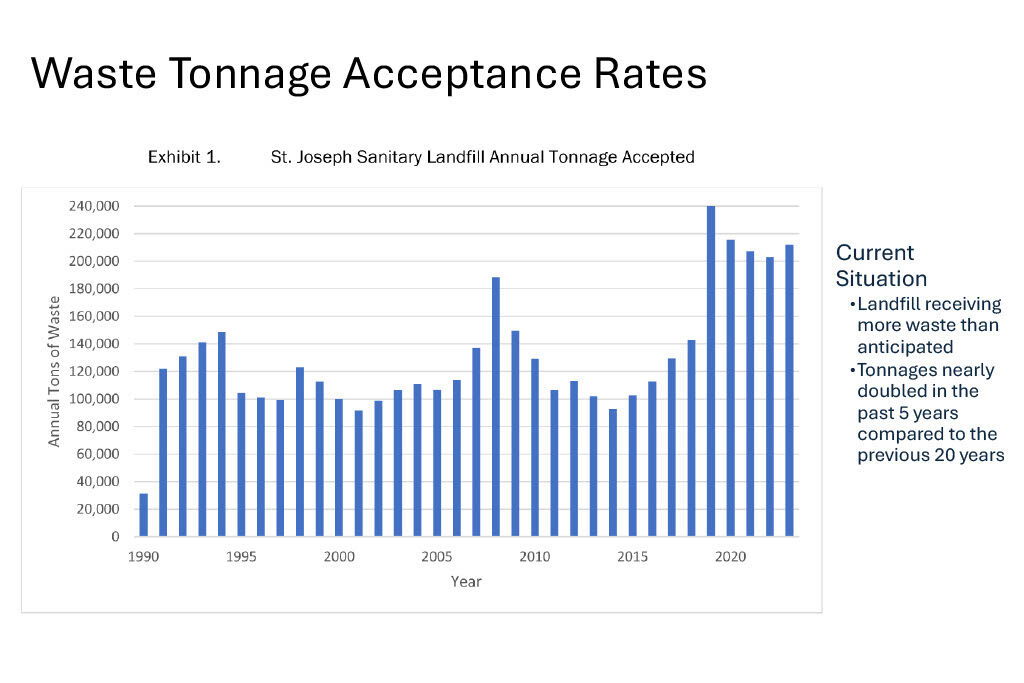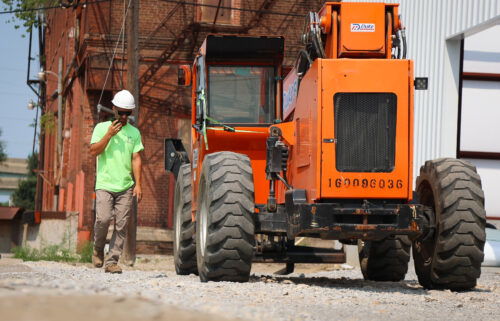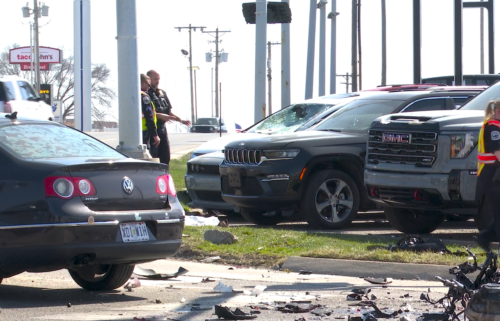City takes aim at shrinking landfill lifespan amid surge in waste

By Cameron Montemayor
A compromise on new dumping fees at St. Joseph’s landfill has put one public concern to bed, but long-term planning and work to address a substantial increase in waste remains.
The St. Joseph Sanitary Landfill, a 14-cell facility opened in the mid-1980s, has seen a near 50% increase in yearly waste in the last five years. That has put the city’s lone open cell in jeopardy of closing by next July if waste isn’t significantly reduced or the next space isn’t complete by that time.
In the short term, the closure of cell 7 would force the entire landfill to temporarily close, meaning residents and dozens of businesses and companies would have to travel elsewhere to dump waste and debris until a new area opens. Long-term, the five-year increase from 110,000 tons a year to more than 215,000 has reduced the entire landfill’s projected lifespan by upwards of 20 years, according to consultants and city engineers.
“According to our engineers’ stats that we have, our landfill could last up to 2047,” said Abe Forney, St. Joseph’s director of public works and transportation. “We’ve always been monitoring the life expectancy of the landfill and we’ll continue the more the trash comes in.”
Excavation on cell 8 is underway and construction will resume once weather permits next spring, as clay material used as a liner for the cells cannot adequately settle in winter conditions. Construction delays have also weighed on the cell’s opening.
To expedite construction and avoid a potential shutdown, the city plans to use revenue from an increase in dumping fees, a result of a compromise with the community following backlash to a 290% increase in per-ton fees, to hire a contractor to complete it. Including cell 8, long-term plans call for the construction of six additional cells before 2047.
“As soon as cell no. 7 was completed and we started putting trash into it, we started working on cell no. 8. So we’ll do that with cell no. 9 as soon as cell no. 8 is completed,” Forney said.
Studies from landfill consultants attributed the massive increase in waste to years of low dumping fees luring large commercial haulers carrying up to 23 tons to St. Joseph, one of the few city-owned landfills in the area. Until recently, rates had changed little since 2002, hovering between $30 and $34.
“People started taking their waste to a transfer station and putting it on a semi-truck and hauling it off to your landfill,” said Bret Clements, vice president of SCS Engineers, during a work session in November.
Of the 211,880 tons of waste received in 2023, nearly 40% of it came from large transfer haulers, according to landfill vehicle data.
Cell delay factors in
Construction on a new cell typically begins immediately after the previous one opens, so a new cell is available every three or four years. However, a two-year delay in 2020 that landfill officials attributed to an unexpected layer of rock led to a nearly eight-year gap between the opening of cell 6B in 2015 and cell 7A in the spring of 2023.
The landfill saw its waste skyrocket during that period not long after the city lowered its dumping fee slightly by $2 to $32 a ton around 2018. The result was a surge from 350 tons a day to upwards of 1,000 tons in recent months. At the same time, the annual number of vehicles grew by 40,000, putting considerable pressure on the facility at a time when work on future cell space was being delayed.
“That was the reason we adjusted those rates downward was in order to capture that business, which obviously it’s all catching up with us now,” City Councilman Marty Novak said during a work session Nov. 12.
The closure of Lee’s Summit landfill in 2019 along with an increase in fees by numerous landfill competitors likely played another role in the city’s increase.
City leaders were given a recommendation from a consultant’s fee study last April to raise the rate from $32 a ton to $75 but elected to forgo the increase in favor of adding a new lane to accommodate the influx of vehicles.
An ongoing challenge that will shorten the lifespan of future cell 8 — expected to reach capacity by 2029 — is the fact that a large percentage of space will be taken immediately upon completion by a buildup of emergency storage. St. Joseph’s emergency storage is essentially full.
Emergency storage — an arbitrary limit dictated by the Missouri Department of Natural Resources — involves stacking waste in a pyramid on existing landfills above normally accepted elevation levels to temporarily accommodate waste. That waste must immediately be relocated to a new cell upon completion.
“One of the reasons stage 8 will fill up faster than it should is because of the overburden,” said Rod McQuerrey, St. Joseph superintendent of solid waste/recycling, during a November work session on landfill findings and recommendations.
St. Joseph will look to embark on the next phase of work at the landfill without McQuerrey, who has plans to retire.
Dumping fee dilemma and new path forward
To drastically reduce the rate of dumping and extend the life of cell 7 and the entire landfill, city leaders agreed to a compromise on higher dumping rates after initial proposals for a broad increase to $125 a ton sparked widespread concerns from area haulers and residents. Many were fearful of an unmanageable increase in operating costs and the impact on customer prices.
The city will implement a new three-tier fee structure that charges a flat rate of $20 for cars and SUVs with no open cargo and $40 a ton for commercial trash haulers (pickups and packing vehicles), roll-off containers, dump trucks and semis.
Large transfer station haulers will be charged $150 a ton, addressing the primary source of the city’s massive influx in landfill dumping from the largest outside haulers. The council will vote on the new rate structure at its Jan. 6 meeting to make rates effective around Feb. 6.
The new fee structure is not intended to be a permanent long-term solution, but instead a shorter-term compromise that minimizes significant and sudden impacts on local haulers while also allowing the city to curb outside dumping.
“I think we came up with a great compromise,” said Jacob Petersen, co-owner of Redgate Disposal, at a Dec. 3 work session on landfill rates. “With the emergency that was presented to everyone, I’m hoping in the future that the city will plan forward further and not be an issue in the future.”
In light of the situation, councilmembers are supporting the creation of a new Landfill Commission represented by local experts and industry leaders to meet regularly. Moving forward, the city plans to conduct new landfill fee studies every year to adjust and prepare as needed.
“I’m excited that the board is looking at doing a commission to review the landfill prices, there’s going to be a lot of value to that, bringing in people that are experts on the ground,” Peterson said.
Time will ultimately tell if the increase in rates will have the desired outcome on waste reduction. Officials are setting a target to reduce annual waste to 150,000 tons or lower, a move that if successful could theoretically extend the life of the landfill beyond 2047.
“The more that we can investigate, the more that we can do to make sure that everything works for the city and works for the community and the people that use our landfill is going to be beneficial for everybody,” Forney said. “We want to continue to explore new ways of doing things. We want to be better at managing the landfill.”
Discussions on long-term future
Landfill conversations have brought to the forefront ongoing work by the city to prepare for the landfill’s end potentially in 2047 barring expansion beyond the planned 14-cells or a significant reduction in waste.
“You’re gonna have a challenge growing this landfill to the east because of the creek, to the north because you don’t own land, to the west because you don’t own land, to the south because of the river,” Clements said.
The Missouri Department of Natural Resources, which regularly inspects the landfill, requires the city to have a fund to pay for all the environmental requirements to effectively close the landfill and monitor it for 30 years.
“We have around $11 million in the closure, post-closure fund right now. According to what the DNR wants us to have is around $18 million,” Forney said. “That number will grow over the years as we add more cells and if we get more land to airspace with the DNR. So it’s a moving target.”
Forney said closure and post-closure of a landfill requires strict and regular tests to limit exposure to methane gases and prevent groundwater from leaking in, among other key requirements.
“After our airspace is completely full, we will cap it with another layer of plastic and clay and then grass. That keeps the water from penetrating the landfill,” Forney said. “They want 80% grass grown over the top of that landfill. They’ll have compacted areas that will settle even more and that will sink in so we’ll have to re-compact that.”
Once the landfill is closed, the city will have to take a hard look at the feasibility of opening another landfill, a difficult and extended process that could take more than a decade to authorize and finalize.
Concerned residents and city officials in Raymore, Missouri, just south of Kansas City rejected the planned construction of a new landfill earlier this year, a saga that ended with Gov. Mike Parson signing a bill to kill it by increasing the municipal approval radius to one mile for new landfills.



